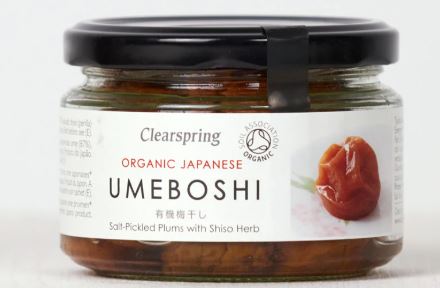未分類
Macrobiotic Nutrition & Lifestyle: The Superpowers of Umeboshi Plum
Umeboshi Fruit, Harvesting and Preparation
Umeboshi is a species of fruit-bearing tree sharing the same family roots with cherries, peaches, nectarines, apricots, and almonds. Umeboshi which is often called a “plum” is actually a cross between an apricot and plum.
Traditionally made by harvesting ume fruit when it ripens around June, young umeboshi are packed in barrels with shiso leaves (which add flavour and a pinkish red colour), water and 20% sea salt per weight of fruit. The sea salt extracts a salty sour liquid called umezu, often translated as “ume vinegar”. Ume soaks in it for about two weeks and is then ready for consumption.
Finished umeboshi plums have a sweet, sour and salty flavour and traditionally served as a side dish for rice or eaten on rice balls for breakfast and lunch, but can also be used to season salads, boiled vegetables and even pasta sauces.
In macrobiotic nutrition, thanks to its many alkaline properties, umeboshi plums, paste and vinegar hold a very special place and are often used in cooking and preparation of medicinal drinks.
Umeboshi Chemistry
Umeboshi are a good source of polyphenols, which reduce the risk of diabetes, help lower blood pressure, prevent hardening of the arteries, and boost calcium absorption. Sea salt, citric acid, and polyphenols also contribute to antimicrobial activity, so umeboshi are a natural preservative for foods and help prevent food poisoning and other bacterial stomach problems.
Benzoic acid, a key component of umeboshi’s preservative properties is also an important part of the aroma. The compound limits the ability of bacteria to proliferate, a trait thought to be one of the reasons for the popularity of umeboshi in rice balls.
It has been recently found that heating umeboshi produces vanillin, a chemical that helps to restrict the bloating of fat cells, providing support for people trying to control their weight.
One potential drawback of umeboshi is the high sodium content, though this makes umeboshi an effective way of combatting the dangers of heatstroke during the brutal summers. Still, it is probably a good idea to avoid consuming too many umeboshi on daily basis. Like with every other food, moderation is the key.
Umeboshi’s Medicinal Properties
The small, wrinkled umeboshi plums are full of health benefits. They help the body absorb calcium, increase saliva production and improve digestion, soothing headaches and activating metabolism, preventing nausea and combating systemic toxicity (including hangovers). Umeboshi also protect against aging!
Citric acid, along with lending umeboshi a mouth-watering sourness that sharpens the appetite, improves circulation and boosts the immune system, reducing the chances of coming down with a cold or catching a nasty bout of the flu. Umeboshi’s antibacterial effects proved very useful during the epidemics of cholera of the nineteenth century in Japan.
Umeboshi has also been shown to limit the activity of the pylori bacterium, a leading cause of gastroenteritis, stomach ulcers, and stomach cancer. In addition, it boosts energy and aids the body in recovery after exertion by helping break down and flush out lactic acid, one of the causes of physical fatigue.
Traditionally, for their energizing qualities, umeboshi were esteemed by the samurai to combat battle fatigue. Today, in Japan they are still consumed to regain energy. Eating umeboshi in Japan is the equivalent of the English expression “An apple a day keeps a doctor away”.
To this day, however, the active ingredients of umeboshi and their health-giving effects are not widely known among the public.
Umeboshi in Cultures Around the World
The umeboshi style of pickling is common in Japan and is similar in style to other Asian preserved pickling techniques found in China, Vietnam, and Korea.
In South Asian countries, a fruit called “amla” in Hindi, or “amala” in Nepali, is prepared in the same way, but with Indian gooseberries instead of ume.
In Mexico, it is known as “chamoy” and is usually made with apricot, ume or tamarind and a mix of salt and dry chili.
In South Africa, a similar style of preserved dried fruit is used to produce a salty, acidic variety.
People in Japan have eaten umeboshi for centuries, having learned from experience of their restorative and preservative properties along with their virtues in helping to ward off colds and other bugs.
When umeboshi were first introduced to Japan 1,500 years ago from China, they weren’t seen as a food but as medicine. Called “ubai” in China, these small plums macerated in salt is cited in Chinese pharmacopoeia written 2,000 years ago.
From the twelfth century, umeboshi consumption became very popular among priests and samurai who attributed extremely powerful effects to it. It was able to revive a fighter, or even bring him back to life!
Preserved, and therefore able to be stored a long time, samurai consumed umeboshi on the battlefield for its nutritional benefits. It was in the nineteenth century that umeboshi found its place on the Japanese table and usually served as a side dish for rice or eaten on rice balls (often without removing the pit) for breakfast and lunch. They are occasionally served boiled or seasoned for dinner.
Younger Japanese today are eating far fewer umeboshi than previous generations did. However, proponents are fighting back, arguing that the combination of health benefits and unique flavour make the humble umeboshi the ideal superfood for the twenty-first century.
A few Umeboshi characteristics:
- Tart salty plum, pickled with red shiso leaves
- Juicy pulp and delicious flavour
- High citric acid content (higher than lemons!)
- Fights fatigue and systematic toxicity
- Aids digestion
- Helps manage weight
- Activates metabolism
- Increases immunity
- Protects from aging
- Known as “King of the alkaline foods”
Clearspring Umeboshi Product Reviews
Salt-Pickled Umeboshi Plums with Shiso
The first time I truly witnessed the power of umeboshi plums was when I was 15 years old. I was fairly new to macrobiotics and often witnessed my mother, who was battling a Stage IV cancer use them to prepare home remedies; medicinal drinks that fight infections, alkalize the blood and heal the cells. After 6 months of practicing macrobiotics, my mother’s cancer stopped spreading and all of my allergies went away.
But the most immediate power of umeboshi plums, praised for their many healing properties, including combating systematic toxicity, I witnessed at a house party when I was 17 years old. A young guy, who we’ll call Jack mixed too many alcoholic drinks and was in a serious trouble. He was past the point of convulsions and his body was going into a shock. Minutes before we were to call an ambulance, a macrobiotic teacher who also happened to be at the party pulled out an umeboshi plum from his pocket and with a little bit of manoeuvring we were able to get Jack to swallow it. Literally within minutes, Jack’s spasms stopped and nausea receded shortly after to the point he was able to go to asleep. I was simply blown away by the power of umeboshi – one magically alkaline plum that literally saves lives!
Over the years I have consumed umeboshi plums in small amounts, since they are quite salty and sour. A whole plum, is too much for the body, but in small amounts umeboshi has been like “an apple a day” for me and my family.
Since I arrived to Hong Kong, I have used Clearspring’s umeboshi plums for preparing home remedies and find them not only great tasting but also of excellent quality. Packaged in a glass jar, which I prefer over plastic, and packed with shiso leaves which I use for making sauces, Clearsping’s umeboshi plums deliver with each healthy bite.
Umeboshi’s antibacterial effects proved very useful during the epidemics of cholera of the nineteenth century in Japan.
In recent weeks of the coronavirus looming over the population of Hong Kong, and now other places in the world, I have been strongly recommending to my clients, and especially for those who travel, to bring umeboshi plums with them as a protection agent against the virus. Specifically, I have instructed them to prepare a medicinal drink called “Ume-Sho-Bancha” (recipe below).
Ume-Sho-Bacha
This drink is used to strengthen and promote digestion, boost immunity and restore energy.
- Prepare Kukicha Tea: bring 3 tsp. Kukicha (loose Twig Tea) and 3 C filtered water to a gentle boil. Simmer covered for 5 minutes. Strain and set aside.
- In an empty teacup add pulp of ½ to 1 organic umeboshi plum that has been chopped or ground to a paste.
- Add several drops of organic, alcohol, and sugar-free Shoyu (soy sauce) and stir gently.
- Pour 1C of hot Kukicha over umeboshi and shoyu.
- Drink while hot.
Suggestions for use: 1 cup, 1 hour after breakfast, daily, for 7 days or during the duration of the trip.
Umeboshi Paste by Clearspring
If there is one thing these days you should not forget to take with you when you leave the house (and no it’s not your cell phone) it’s a paste made of umeboshi plums. Super concentrated, a small amount, as little as ¼ to ½ teaspoon of umeboshi paste simply dissolved in a cup of little hot water can do wonders for headaches, stomach aches, nausea, cramps, fatigue, and boosting immunity.
Especially if you are traveling, umeboshi paste should be your trusted travelling companion, within hands reach at all times. Think of it as an antibiotic with superpowers. I usually bring it in a little glass jar and all I need to do is ask for a little hot water and I am ready to go.
I have found Clearspring umeboshi paste become my trusted alkaline sidekick. Although I prefer plums, since they are easier to gage, amount wise, paste is irreplaceable when making medicinal drinks on the go or bringing out the flavours of the dishes I am preparing. Most recently I’ve used it, in a small amount, in a tomato based pasta sauce to cut down on tomato acidity and it did wonders for the flavour as well. It actually made the sauce taste sweater. Small amount of umeboshi paste goes a long way, so think ½ pinkie nail size rather than a thumb nail. In any case, Clearspring delivers again and considering they use all organic ingredients and not just any salt but sea salt, I am stocking up!
Ume Plum Seasoning (Umeboshi Vinegar) by Clearspring
I use umeboshi vinegar on daily basis, in seasoning salads, broths, and even boiled veggies. The taste is sour-salty but when sprinkled on boiled vegies it brings out the sweetness. Most recently I used it on boiled cauliflower and just loved it. Also, when making pickles and my famous coleslaw, umeboshi is my go-to seasoning. I usually add a little brown rice vinegar and the two make a dashing couple.
Clearspring’s umeboshi vinegar hasn’t let me down yet and I’ve gone through several over the last few months. Every bottle had the same colour, texture and it tasted the same. The quality is undeniable and the only thing I wish is that Clearspring offered it in a larger bottle. The current size is great for occasional use and traveling but for daily consumption a little inconvenient – unless, of course, you live two blocks from FoodCraft! Then, well then you have nothing to worry about.
Umeboshi Shiso Vinegar by Clearspring
Umeboshi vinegar has become one of the essential ingredients I use to season variety of dishes, but it isn’t until recently I discovered the Ume Shiso Vinegar. Made with an addition of shiso leaves, which are usually added to brine and umeboshi during the pickling process, shiso gives the predominantly sour umeboshi vinegar and extra kick. An extra kick of salty and tanginess, that is. I have found the combination great for pickling and making salad dressings since you really don’t really need to add extra sea salt.
I’ve put Clearspring’s Ume Shiso Vinegar on the gift list for my mother and macrobiotic friends back home, in the U.S. Can’t wait to try all the new dishes we will make with it!
Written by Srdjan ‘Serg’ Dobic from @Equilibrium


